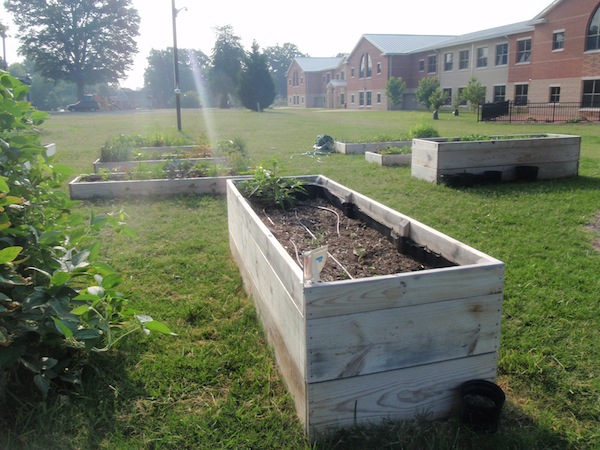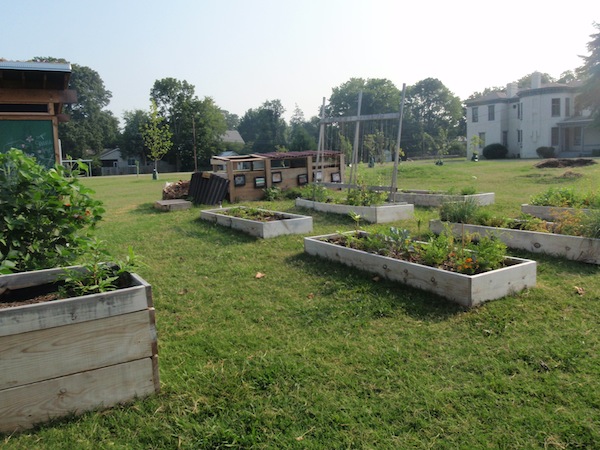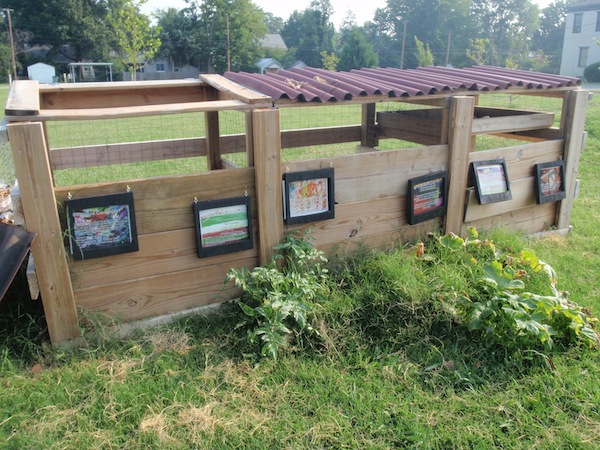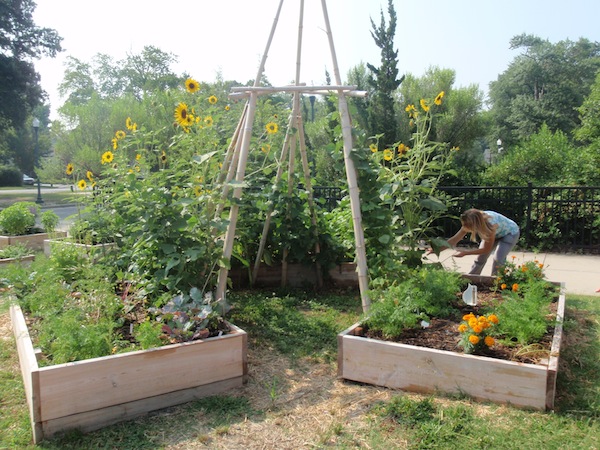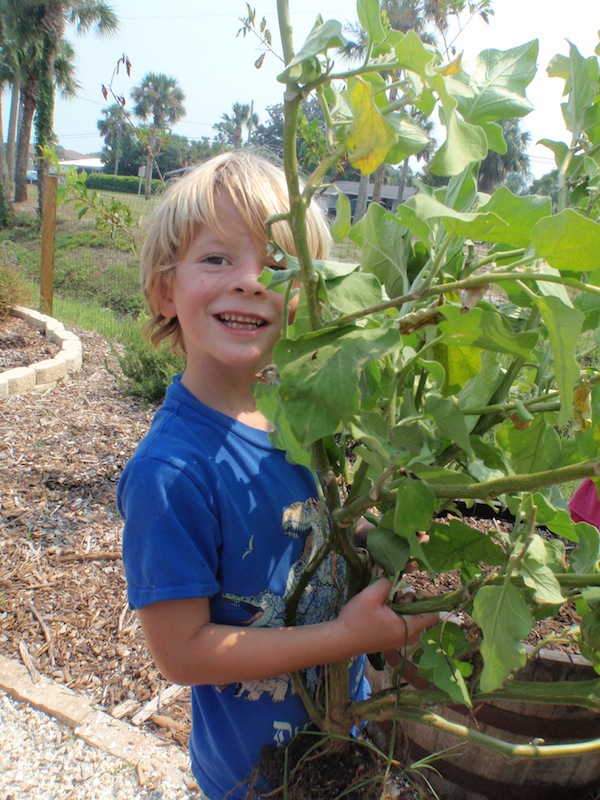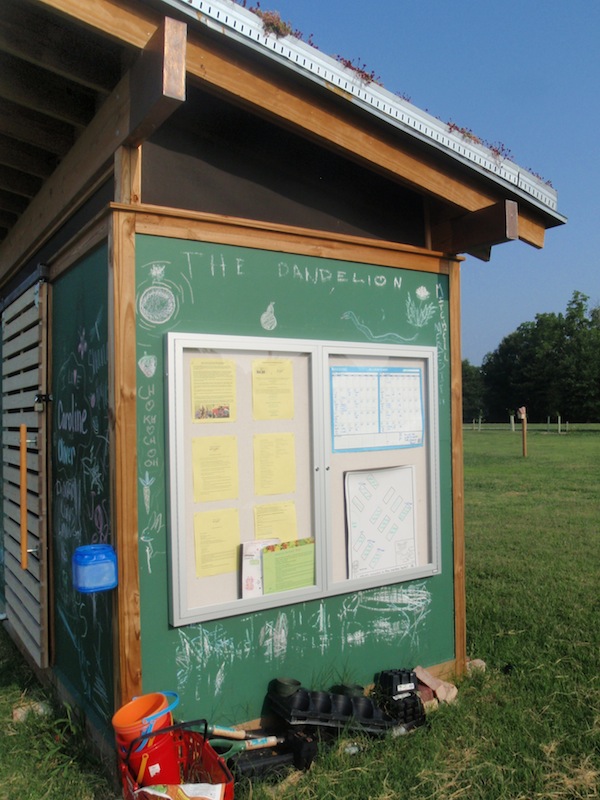Wonder Wednesday #9: Putting your School Garden Beds to Bed – Cover Cropping
When introducing children to the school or community garden beds and teaching them the names of the garden areas, I always ask them if these are beds you sleep in. The older children think I’m corny and roll their eyes while quietly chuckling and the younger children take the question seriously and answer no, but then get to laughing once they see me laugh at how silly my question is. By the time the school year is coming to a close, the children have a much different relationship with the space and so when I say that we are going to be putting the garden to bed for the summer they think I am just being corny again. A lesson on the hows and whys of putting a garden to bed for the summer is a great way to introduce the importance of cover cropping and letting areas lie fallow.
The summer garden at Holton Elementary in Richmond, VA. You can see they have some small drip irrigation in some beds, but this garden still requires volunteer watering. We visited this school as part of the University of Richmond’s Nature and Sustainability Institute Developing an Outdoor Classroom week long course for teachers that I took and now teach in.
Summer is a tough time for most school gardens. Teachers and garden managers are stuck with the question of whether to let the plants keep growing and hope that it either rains regularly or that the scheduled list of volunteers remembers to fulfill their promise of watering. (I’ll get more into a summer schedule in a bit.) Do you let the weeds grow up and plan a volunteer work day the week before teacher work week to get it back in order, do you let the children see how it looks after a summer of semi-neglect, or do you put it to bed and let nature take its course? There is no right answer for every garden or every school year.
In Florida, we are lucky because our growing season lines up very nicely with the school year. This makes the answer easy- put it to bed. In northern areas, summer’s when your garden really starts producing, so in those regions I’d say make an awesome volunteer schedule. In areas in the middle, you have to make the call. Maybe you experiment and do something different each year. I talk about this topic in relation to summer, because that’s my growing downtime due to excessive heat, but those of you in northern regions can do this lesson in the winter for the opposite reason- cold! But summer break does still apply to you too so perhaps you do different seasonal experiments. Also, you could just scale down your garden for the summer and let some beds grow and other get cover cropped, then the following summer rotate those beds.
Some of the beds are planted with veggies, but some are empty.
Before I get carried away with alternative options, let’s get back to putting it to bed. Cover cropping and letting fields, or in our case beds, lie fallow is an important part of sustainable farming. Growing crops in the same areas season after season greatly depletes the soil, so just as we rest in our beds, we need to give our beds a rest. This can be done by leaving one bed fallow every year if you have that kind of space, or if not, you can cover crop over a season and then “turn in” the cover crop at the beginning of the school year to return the nutrients back to the soil in which the crop was growing. (Turning in does require a few weeks of garden rest after the plants are in the soil, so be sure to research this and make sure to choose the plant and method that best suits your needs. The Mother Earth article link below has info on this on page 2.) Cover cropping goes right along with crop rotation which is the practice of not repeatedly planting the same plant variety in the same place in order to deter pests and disease.
I love their composting bins. They are attractive and very functional.
Now you can’t cover crop with just any plant. You want to choose one that will fix nitrogen (like legumes) and other nutrients into the soil, prevent erosion, add microorganisms, keep the weeds at bay (somewhat at least), and be easy to “turn in” or “chop out” for composting by hand – as the children should be doing this step in the process as well. I have provided resources links below that should help you choose the best cover crop for your needs.
A summer parent volunteer in action. Her approximately 2nd grade daughter was watering independently in another area.
You could even have older students run a cover crop experiment by planting different beds with different cover crops and then over the next school year see which beds grow best. This could incorporate preliminary research on which cover crops are best for your area, their pros and cons, and what benefits they add to the soil. Then in the fall, the students can help decide what plant should be planted in which beds based on the nutrient requirements balance with what the cover crops offered and then track growth rates of new plants. This info could be compiled in a pamphlet on the benefits and how to’s of cover cropping in your area for optimum plant growth and production and presented at a local library or to the parents at a garden workshop. (This would be really interesting in colder regions with that earlier idea to test seasonal cover crop plant varieties.)
Wonder Wednesday: Putting the Beds to Bed: What is Cover Cropping?
This is a basic lesson structure into which you can add your own twist and specifics to based on your region, garden size, volunteer quantities, and needs. It requires a little specific local research, but don’t worry, not too much! You may even use this as an excuse to get an extension agent to come out and speak on the topic.
Introduce the children to the concepts introduced above as to why we would need to put the garden to bed and how the qualities of a particular season make cover cropping a good idea. (Ex: summer is too hot or because no one is at school, winter is too cold)
Explain to the students how they will wake the garden back up when they return to school in the fall by shoveling up their cover crop and either burying it back into the soil or composting it to “feed” the new plants and the soil- this will depend on which cover crop plant variety is chosen. You will have to develop this part of the lesson for your region and needs specifically.
(This could be a good time to review soil structures and how soil is living if you are working with older children.)
This is the part the kids always love because so often they have to be so careful in the garden. They get to pull out the plants!! WARNING: the children can get wild during this! Be very aware of energy levels and before the pulling begins you must explicitly explain which plants are to be pulled. You could even mark the plants to be removed with a ribbon as a visual cue because without fail, a plant that is not supposed to get removed gets pulled by someone who wasn’t paying attention or who got caught up in the frenzy of pulling out plants. I have no idea why they tend to get wild when they pull out plants, but it always seems to happen no matter how prepared I am!
He was so happy to have pulled out his huge eggplant! It was a great test of motor skills and strength!
Have the children dispose of the pulled plants in the appropriate way for your school or garden. This may involved either chopping them with shovels to prepare for putting them in the compost pile or putting the plants in a designated yard waste disposal area. The garden should look as tidy afterward as it did when they arrived.
This part may be day 2 of the lesson or done with a different class
After the designated plants are removed, have the children rake the garden soil flat again and perhaps add in a layer of compost if you have it to get the soil ready.
Then have them plant the cover crop seeds. I usually let them do this in a scattering way.
Press the seeds into the soil gently and then cover them with another layer of compost generally about a half an inch thick or so.
Have the students water the cover crop seeds each day until the end of school. If using different types of cover crop seeds you could have them track and graph which ones sprouted first.
In the fall (or next season)
Depending on what crop you chose and your particular situation, chop up the cover crop with shovels and either “turn in” or pull out and put into your compost bin.
Rake your soil to make it nice and smooth and tidy.
Then, either let your beds rest for 3-4 weeks if you turned in your cover crop or if you decided to put the removed crop into your compost pile, add a layer of fresh compost and begin your fall planting! You have come full circle now!
Summer Schedules
For my classroom/school garden, about a month before school lets out, we would create a calendar for the summer. Just the regular old style of months with squares, one page for each month of summer vacation. Then, we (as in my co-teacher and I) would give these sheets to the room mother and have her organize parents to volunteer a week at a time to come over the summer and water. With the calendar sheets, we would give her an instruction sheet so she could describe what the job entailed and make clear that they are only responsible for watering. No big deal if anything dies, they aren’t responsible for anything more than watering. (Some parents were quite worried about their perceived “brown thumbs.)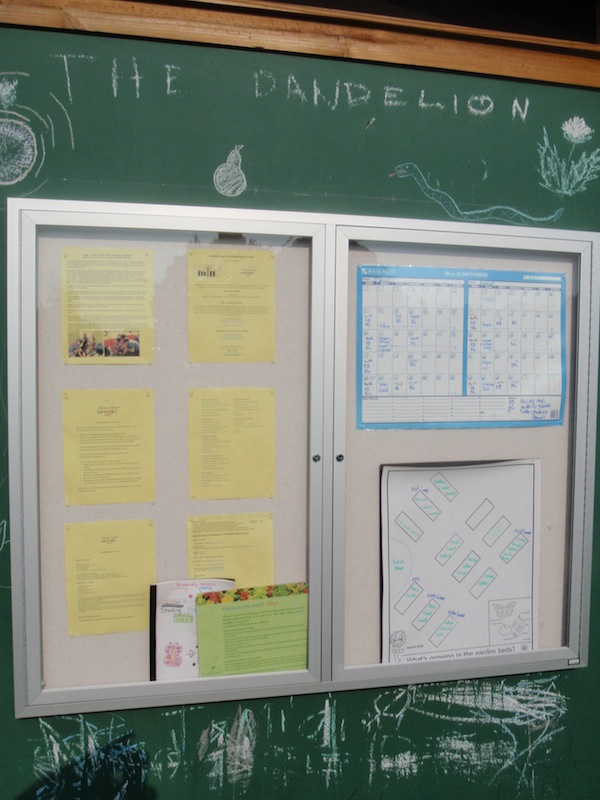
Holton has an awesome shed that has the summer calendar watering schedule posted for all to see and double check along with instructions and other reminders. I would love to have this system!
Some parents volunteered for more than one week and some for no weeks, but it always worked out and the garden, in whatever state of totally cover cropped to none at all, got watered 2-3 times a week. The room mother would return the sheets to us and we would verbally confirm with the parents the last week of school in person or by phone and give the volunteers a copy of the instruction sheet. You can never have too many reminders! We always received great feedback from the volunteer parents about how their children were very excited to come and tend the garden over the summer. I always had an open harvest policy also for the volunteers. If you see it over the summer, pick it and enjoy! Just a little perk!
Seeds to Sprout:
The basics on and benefits of cover cropping by Organic Gardening Magazine
A great Mother Earth News article on cover cropping. See page 2 for specifics on turning in your cover crop.
Why cover crop? by Cornell University
A list of cover crops by region by the Farmer’s Almanac
Purdue University Extension’s recommendations on cover cropping for nitrogen, as preventative planting for extreme weather and soil health, and an overview of benefits
Cover crops for home gardens by Oregon state University
The University of Richmond’s Nature and Sustainability Institute Developing and Outdoor Classroom week long course is awesome!! I’m not just saying that because I teach in it, but because when I took it the first year I gained invaluable information from landscape designers, botanists, grant writers, and the other teachers that played a huge part in the research for my book! Check it out and maybe I will meet you there!
The full shed pic- I couldn’t resist!! I just love this shed!! The roof is living and the backside is a ceramic tile mosaic that the children created with the art teacher. What a dream,right?!!

